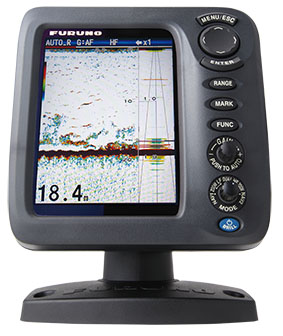Furuno FCV-600 and FCV-800, expanding the meaning of standalone fish finder

Last week, I helped judge the Technology and Best New Product awards at the National Marine Electronics Association’s (NMEA) annual conference. Furuno’s FCV-600 and FCV-800 standalone fish finders received the Best New Product award. I enjoy participating in these sorts of contests because of the opportunities I’m afforded to dive deeper into new products. The new FCVs are great examples of compelling new products I might otherwise have missed.


The 5.7-inch FCV-600 and 8.4-inch FCV-800 succeed the FCV-628 and the FCV-588, respectively. The outgoing finders offered dual-frequency 50 and 200 kHz continuous wave (CW) capabilities but lacked CHIRP. The new fish finders are compatible with both technologies. In fact, a single fish finder can support a single channel of CHIRP and dual CW or dual CHIRP.

The FCV-800 includes NMEA 0183 and NMEA 2000 interfaces while the FCV-600 only has a NMEA 2000 interface. They offer RezBoost signal processing, bottom discrimination to identify rock, sand, gravel, and mud bottoms, Accu-Fish size and depth assessment, a wide array of color options — including palettes optimized for those with differing color sensitivities — and TLL target lat and long to mark fishing grounds with information about fish observed. The sounder in FCV-600 is a 600-watt RMS model and the FCV-800 offers a full one-kilowatt RMS outpu. They both support a depth range of 2 to 1,200 meters.
Wireless networking

But, the differences aren’t limited to just the addition of CHIRP capabilities. The new fish finders feature WiFi connectivity to allow external display possibilities. There’s a certain, pleasant irony to networking capabilities being one of the main features of these standalone fish finders. Ironic or not, the new fish finders can wireless link to another, matching, FCV, an iOS device running TZ iBoat, or an Android mobile device running NavNet Viewer. Plus, Furuno hinted at other integrations in the future with more of their product line.
I believe these wireless capabilities make the FCV-600 and 800 a great tool for many applications. Exact pricing hasn’t been announced, but the outgoing 5.7-inch FCV-628 retails for $695 and the 8.4-inch FCV-588 retails for $1,345, both prices are without transducers, but more on why you might not need one in a minute. The expectation at the show is that the new models might be $150-$200 more expensive than the outgoing, non-CHIRP ones. So, If we figure on something like $850-$900 for the FCV600, even a pair remains pretty affordable compared to most other options.
Backward compatibility
I cover a lot of different products and certainly at times don’t give them all the attention they deserve. Sometimes, like during my conversation with Matt Wood, Furuno USA’s national sales manager, I learn about a product’s features or capabilities I probably should have already known.
Matt explained the FCV’s impressive compatibility paired with Furuno’s commitment to supporting existing transducers. It turns out that for several generations of their stand-alone fish finders, Furuno has supported nearly any brand’s transducers. Matt reports that more than 95% of the transducers they’ve encountered have been successfully paired with the FCVs. In light of the potential cost and hassle of hauling a boat, drilling a new hole, and patching an existing one. that’s a big deal to a lot of boat owners.
Furuno offers a host of wiring adapters to make connecting many transducers plug-and-play. But, even in cases where there’s not a plug-and-play option, a junction box and custom settings can usually get the transducer online and playing nicely with the FCVs.
Final thoughts
I spend a lot of time covering the newest trends and products in marine technology. Often, that doesn’t include tried and true technology like stand-alone fish finders. But, I think the FCV-600 and 800 remind us there’s good stuff happening in many facets of the market. I’m very happy to know that an affordable, compatible, and capable stand-alone option exists and will surely find myself












Complete NMEA 2023 Awards here: https://panbo.com/nmea-names-2023-award-winners/
You guys can be forgiven for missing some key points since you don’t do a lot of fishing. There are many people who just prefer a standalone fishfinder to using a multifunction display because of its portrait display orientation or ease of access to controls with dedicated buttons. Others have have legacy chartplotters or other manufacturers’ equipment and want to have a Furuno sounder. In that context , the FCV-800 has some interesting features. Most notable is the ability to drive three channels usiing the two transducer ports. This is not possible with the internal sounder of a TZT 3. Medium band CHIRP transducers have become popular for trolling in the past few years. With a TZT 3, if you want to connect a medium band transducers such as a B175M, you have to sacrifice the high frequency port unless you have two MFDs. Otherwise you can only have H+L or M+L. With an FCV-800, it is possible to have H+L on one port and M on the second.
On the negative side, the FCV800 does not have the selectable frequency output of the TZT 3 internal sounder. I can drive my B175H transducer as a fixed frequency at 210Hz or CHIRP over its whole band or in a custom narrower CHIRP band. With an FCV800, it could only operate in CHIRP across the full band.
Anyway, these new fishfinders offer an upgrade path for people who have very old Furuno sounders like the popular FCV582 — which are excellent machines and never seem to die!
The TZ iBoat module that can display and control these fishfinders is now available:
https://www.furunousa.com/en/company/news_room/2024_fcv-tz_iboat_app